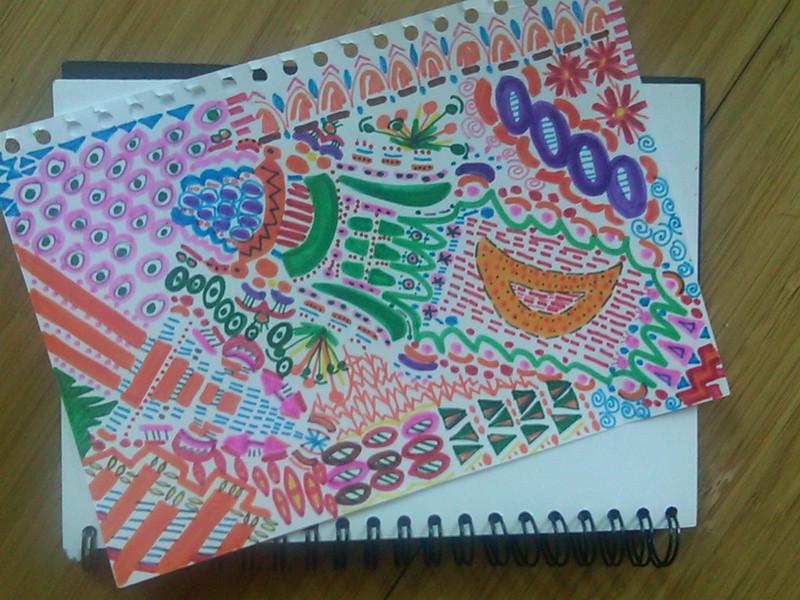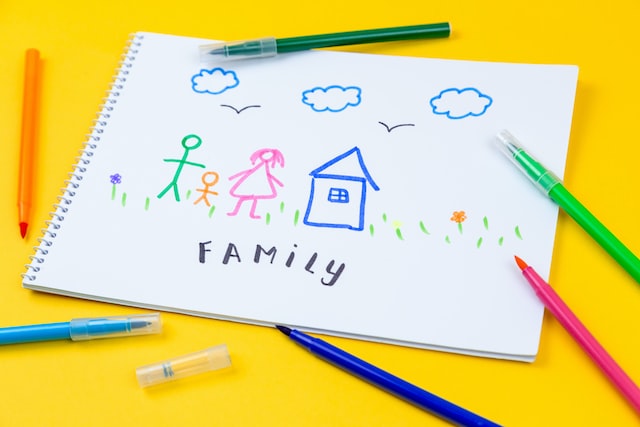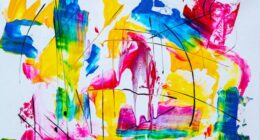Doodling is typically a casual, unfocused activity of drawing random shapes and patterns, often done while thinking or talking. Sketching, on the other hand, is a more deliberate and intentional act of drawing, usually with the goal of capturing an image or idea for later use.
What is Doodling?
(Photo By lizasperling on Flickr)

Doodling is an informal and spontaneous form of drawing that is usually done without a specific purpose or plan. Doodles are often created when a person is bored, thinking, or simply wants to relax. Doodles are usually simple drawings that are drawn in a free-flowing manner and are often created quickly and without much thought.
What is Sketching?
(Photo by ConvertKit on Unsplash )

Sketching is a more formal and deliberate form of drawing that is used to capture an idea, plan, or composition. Sketching is often done with a specific purpose in mind, such as creating a preliminary drawing for a painting or working out the details of a design. Sketching usually involves more careful and intentional lines, shading, and other techniques to create a more finished image.
What is the difference between doodling and sketching?
When it comes to drawing, there is a big distinction between doodling and sketching. Doodling is usually considered to be a more casual activity, while sketching is seen as more serious or formal. For example, you might doodle in the margins of your notebook during class, or when you’re on the phone. Sketching is often used for planning out projects or for creating finished pieces of art.
Doodles are usually less detailed and more spontaneous than sketches. They can be simple shapes, scribbles, or words. Sketching often involves more planning and forethought than doodling, and the results are usually more polished and refined.
One way to think of the difference between doodling and sketching is that doodling is like thinking with your pencil, while sketching is like thinking with your hands. Doodling can help you process your thoughts and come up with new ideas, while sketching can help you visualize those ideas and turn them into something tangible.
Doodling is typically considered to be a more casual activity than sketching. Sketching often requires more planning and forethought than doodling, which is often done spontaneously and without much thought given to the final product.
The benefits of doodling
Doodling can have several benefits for the mind and body. For one, doodling can help to relieve stress and anxiety by providing a creative outlet for emotions. Doodling can also help to increase focus and concentration, especially when it is done during meetings or other tasks that may be boring. Finally, doodling can be a great way to express creativity and emotions, especially for those who may not be confident in their drawing abilities.
The benefits of sketching
Sketching can also have several benefits, including improving artistic skills and creativity. Sketching is a great way to practice drawing and refine techniques, especially for artists who are just starting out. Sketching can also help to develop a better eye for detail and proportion, as well as improve hand-eye coordination. Additionally, sketching can be a great way to capture ideas and plan projects, making it a useful tool for professionals in many different fields.
The use of Doodling and Sketching in different fields
Doodling and sketching can be used in many different fields, including art, design, and architecture. Doodles are often used by artists and designers as a way to brainstorm and generate new ideas, while sketches are used as a way to refine and develop these ideas. Additionally, architects and engineers often use sketches to plan and design structures, while artists may use sketches as a way to work out the details of a painting or other piece of art.
How to get started with doodling and sketching
To get started with doodling and sketching:
- Find inspiration: Look at the work of other artists or find inspiration in everyday life and nature.
- Gather materials: You’ll need a sketchbook, pencils or pens, and erasers. Experiment with different materials to find what you like best.
- Start small: Start with simple drawings and doodles to get comfortable with your materials and build your confidence.
- Practice regularly: Set aside time each day or week to draw and doodle. The more you practice, the better you’ll become.
- Don’t be afraid to make mistakes: Making mistakes is a natural part of the learning process. Embrace them and use them as opportunities to learn and grow.
- Experiment with styles and techniques: Try different styles and techniques to find what works best for you.
- Keep it fun: Above all, remember to have fun and enjoy the process. Doodling and sketching should be a creative outlet, not a chore.
What is difference between sketching and drawing?
Sketching and drawing are related activities that involve creating visual representations using lines, shapes, and shading. However, there are some differences between the two:
Purpose: Sketching is typically used as a preliminary step in the creative process, to explore ideas and work out the details of a composition. Drawing, on the other hand, is a more finished product, meant to capture a subject or scene with greater accuracy and detail.
Style: Sketching is often done quickly, with loose, flowing lines and minimal shading, while drawing is typically more deliberate, with more attention given to accurate proportions, shading, and texture.
Materials: Sketching can be done with a wide range of materials, from pencils and charcoal to digital tools, while drawings are typically done with pencils, pens, or other fine-tipped instruments that allow for greater precision and control.
Intensity: Sketching is usually a more relaxed, less intense activity, while drawing often requires more focus, concentration, and effort.
In general, both sketching and drawing can be valuable tools for artists, providing opportunities for creative expression, experimentation, and learning. The choice of which to use will depend on the specific goals and needs of the artist and the project at hand.
What is difference between doodling and drawing?
Doodling and drawing are both forms of art that involve creating visual representations, but there are some differences between the two:
Purpose: Doodling is often done as a form of relaxation or to pass the time, while drawing is typically more focused and intentional.
Style: Doodling is often more spontaneous, with no clear subject or end goal in mind. The lines and shapes are often simple and repetitive, and the overall look is more loose and organic. Drawings, on the other hand, typically have a specific subject or scene that is being captured with greater detail and accuracy.
Intensity: Doodling is usually a more casual and lighthearted activity, while drawing can be more serious and intense.
Materials: Doodling can be done with a variety of materials, such as pen and paper or a digital device, while drawings are often created with pencils, pens, or other fine-tipped instruments that allow for greater precision and control.
In general, both doodling and drawing have their own unique benefits. Doodling can be a great way to relieve stress and stimulate the imagination, while drawing can help develop fine motor skills, hand-eye coordination, and the ability to observe and capture the world around us.
What is scribbling?
Scribbling is a drawing or writing technique where the artist makes quick, short, uncontrolled marks. This can be done with any medium, but is most often seen with pencil and pen on paper. Scribbling can be used to warm up before starting a more serious drawing, or it can be the final product itself.
Scribbling is usually considered to be less controlled and less refined than doodling or sketching. It can be seen as an exploratory exercise, where the artist is just playing around with line and form without worrying too much about the final outcome. This freedom can lead to some interesting and unexpected results.
What are the types of sketching?
Sketching and doodling are both ways of drawing, but they differ in terms of purpose and technique. Doodling is usually done idly, without much thought or planning, while sketching is done with the intention of creating a finished piece of art. Sketching also tends to be more detailed and precise than doodling.
There are several different types of sketching:
- Gesture sketching is quick and loose, capturing the overall feel or movement of a subject rather than its details. This type of sketch is often used by designers to brainstorm ideas.
- Contour sketching involves drawing the outline of a subject. This can be done freehand or by following a contour map.
- Perspective sketching is used to create the illusion of depth on a flat surface. This is often used in architectural drawings.
- Composite sketching combines multiple sketches into one image. This can be used to create a more complete picture of a scene or subject.
What are the types of doodling?
There are four primary types of doodling: Abstract, Geometric, Representational, and Random.
- Abstract doodles are typically composed of simple shapes and lines that are not intended to represent anything in particular.
- Geometric doodles are usually based on basic shapes like squares, circles, and triangles.
- Representational doodles may resemble faces, animals, buildings, or other real-world objects.
- Random doodles have no specific structure or meaning – they can be anything from a few squiggly lines to an intricate design.
What are the steps to start doodling?
Assuming you would like a numbered list:
- Pick up a pen or pencil and paper (or any other drawing utensil and surface).
- Start making marks on the paper. There are no rules about what kind of marks to make, just let your pen flow.
- If you get stuck, try drawing simple shapes like circles, squares, or triangles. Or look around you and draw something from real life.
- Keep going until you feel satisfied with your doodle.
What are the steps to start sketching?
Assuming you would like a step-by-step guide on how to start sketching:
- Decide what you want to sketch. This can be anything from an object in your room to a landscape outside.
- Find a comfortable position and angle for both you and your chosen subject. You may need to move around a bit until you find the perfect spot.
- Take a look at your subject and mentally break it down into simpler shapes. For example, a tree could be made up of a cylinder for the trunk, spheres for the leaves, etc.
- Start lightly drawing these basic shapes onto your paper with a pencil. Once you have the general proportions down, you can start adding details like shading, texture, etc.
- Keep working on your sketch until you’re happy with the results!
What are the different types of drawing?
There are many different types of drawing, each with its own unique techniques, materials, and styles. Here are some of the most common types:
- Sketching: Quick, loose drawings that capture the essence of a subject or scene without much detail.
- Life Drawing: Drawings created from observing and capturing the human form.
- Portrait Drawing: Drawings that capture the likeness of a person’s face and features.
- Landscape Drawing: Drawings that depict natural or urban landscapes and scenery.
- Still Life Drawing: Drawings that capture still objects, such as flowers, fruits, or household items.
- Figurative Drawing: Drawings that depict the human form, but with a greater emphasis on expression and emotions.
- Architectural Drawing: Drawings that depict buildings and structures, including floor plans, elevations, and sections.
- Animal Drawing: Drawings that depict animals, from domestic pets to wild creatures.
- Caricature Drawing: Drawings that exaggerate and simplify a person’s features for humorous effect.
- Comic/Cartoon Drawing: Drawings that tell a story using illustrations, often in a sequential format.
These are just a few of the many types of drawing. Many artists also combine multiple types, such as portrait drawing with still life drawing, or architectural drawing with landscape drawing. The type of drawing you choose will depend on your interests, skills, and the kind of projects you want to create.
Can a doodler or sketcher become an artist?
Yes, a doodler or sketcher can become an artist. The two terms are often used interchangeably, but there is a difference between the two. Doodling is usually considered to be more spontaneous and less detailed than sketching. A sketch is usually more planned out and takes more time to complete. However, both activities can be used to create art.
Is doodling and sketching considered as art?
Doodling and sketching are both considered as art forms. However, there is a difference between the two. Doodling is usually considered to be more spontaneous and less planned out than sketching. Sketching is often seen as being more refined and polished, as it is often done with the intention of creating a final product.
What are the rules of sketching and doodling?
When it comes to sketching and doodling, there are no hard and fast rules. However, there are certain guidelines that can help you get the most out of your drawing experience.
Here are a few tips for sketching and doodling:
- Use a light touch. When you’re first starting out, it’s best to use a light touch when drawing. This will help you get a feel for the pencil or pen you’re using, and how much pressure to apply to the paper. As you become more comfortable with sketching and doodling, you can start applying more pressure to create darker lines.
- Keep your lines loose. It’s important to keep your lines loose when sketching and doodling. This will help you relax and have fun with your drawing. If you get too caught up in trying to create perfection, you’ll miss out on the freeing feeling that comes with simply enjoying the process of creating art.
- Try different mediums. Experiment with different mediums when sketching and doodling. In addition to pencils and pens, try using charcoal, pastels, or even crayons. Each medium offers a different way of adding line and texture to your drawings.
- Fill the page. One of the great things about sketching and doodling is that there are no rules about how much or how little you should draw on a page. So fill it !.
Featured Image By – Photo by Volodymyr Hryshchenko on Unsplash








